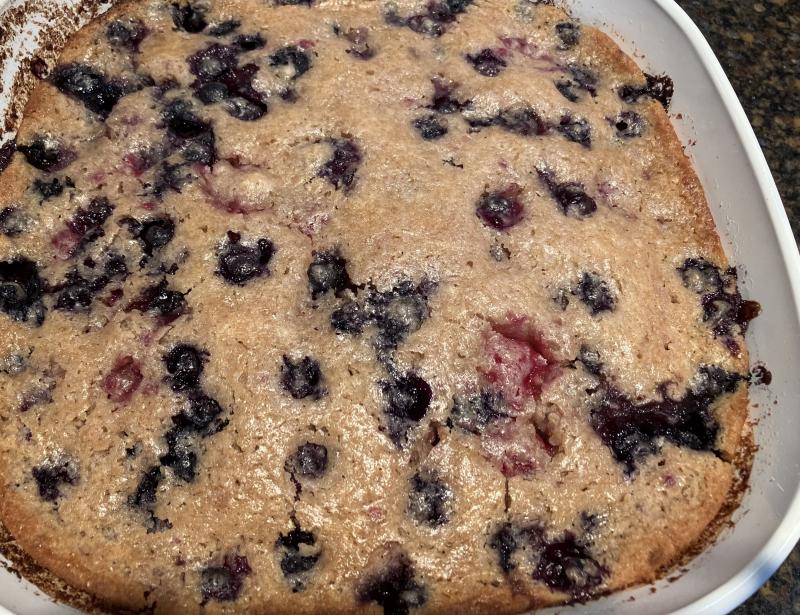Follow recipe directions when using butter in batter
How many times have you found a recipe that begins with instructions to “cream butter” or “cream butter and sugar”? This is fairly typical for cookies, brownies and some cakes. What you’re doing in this step is incorporating trapped air bubbles in the softened butter. As the batter bakes, those bubbles inflate with the help of baking powder or baking soda, providing the final product with an airy lightness.
But, to truly understand what’s happening, we need to consider what is in that stick of butter. Although we suspect margarine and other butter substitutes as a collection of various artificial ingredients, butter is simply made of milk solids (mostly proteins), water and butterfat. In order for the creaming step to go well, you’ll need to make sure the butter has had time to soften, or it won’t blend properly. As your mixer blades whip the butter and sugar, the corners of the sugar crystals leave air trails through the butter.
Like the cocoa butter in chocolate, butterfat isn't actually a single fat but several, each with different characteristics. Part of the fat crystallizes, while part remains in relatively soft globules. When the butter is cold, the soft globules remain thick and sluggish (think molasses). When the butter warms, they soften and allow the crystallized fats to slide apart, becoming spreadable.
You may have seen specialty butters under various European labels that have a greater concentration of butterfat than American brands. The standards set by the USDA require 80% butterfat for the product to be labeled butter here in the States. In countries that are part of the European Union, butter must have between 82% and 90% butterfat, and also measure below the maximum of 16% water. The higher the fat content, the more costly the product, which explains why the imported brands are higher priced at the grocery.
Before reaching for the higher-fat types for your baked goods, may want to consider how that added fat will affect the texture of the finished product. It might work beautifully for a pie crust, but be too much for a light and fluffy layer cake. I wouldn’t hesitate for scones, because of the high flour ratio, but I’d hesitate for cookies that would likely melt and flatten.
Butter can be used in many ways for baking, depending on the result you're looking for. Muffins or coffee cakes often call for it to be melted and simply poured into the dry ingredients to form a batter. Melted and softened butter are not interchangeable in most cases. Softened fats trap air, much like whipped cream, creating a fine, delicate crumb in your cakes.
Melted butter behaves very differently from softened butter, because both the crystalline fats and the softer fats are completely liquid. For baking purposes, the butter is now comparable to vegetable oil, providing the crumb with richness and softness but not contributing to its structure. Baked goods made this way tend to have a relatively coarse, crumbly texture. For the cobbler in the photo, melted butter is used instead of oil because of its superior flavor.
If you need softened butter for a recipe and end up with melted butter, set it aside for another use. If you’re short on time to soften your butter, avoid using the microwave, as it will heat unevenly and often melt it. You can grate cold butter or cut it into thin slices to help it soften more quickly. I’ve included a recipe that features melted butter in a One-Cup Cobbler, whose name comes from the measurements of the ingredients. You can use drained canned fruit pieces or defrosted frozen fruit; it’s not well-suited for harder fresh fruits. The yellow cake recipe creams the butter and sugar into a rich batter that will pair nicely with chocolate buttercream icing.
One-Cup Cobbler
1 stick butter
1 C self-rising flour
1 C sugar
1 C milk
1 t cinnamon
1 15-oz can drained fruit*
Preheat oven to 350 F. Place butter in the center of a small baking dish and place in oven to melt. In a mixing bowl, combine flour, sugar, milk and cinnamon. Remove the pan from the oven and turn it to evenly coat the sides with melted butter. Pour the butter into the mixing bowl, add fruit, and stir to combine. Transfer batter to the baking dish and bake until set and lightly browned, about 45 minutes. Allow to rest for a few minutes before serving. Yield: 8 servings. *Note – you may substitute defrosted frozen fruit.
Yellow Cake*
2 1/2 C cake flour
2 1/2 t baking powder
1/4 t baking soda
1/2 t salt
1 C unsalted butter
1 3/4 C sugar
4 egg yolks
2 t vanilla extract
1 C buttermilk
2 egg whites
1/8 t cream of tartar
Preheat oven to 350 F. Make sure butter and buttermilk are at room temperature. Line two 9-inch round cake pans with parchment paper and coat inside with nonstick cooking spray; set aside. Stir together flour, baking powder, baking soda and salt in a bowl; set aside. Using an electric mixer, cream together butter and sugar in a large bowl until light and fluffy. Beat in the egg yolks one at a time. Stir in vanilla. Add one-third of the dry ingredients and half the buttermilk to the butter mixture; beat on low until combined. Add another third of the dry ingredients and the rest of the buttermilk; beat until combined. Add remaining dry ingredients, beating to combine thoroughly; set aside. In a small mixing bowl, whip the egg whites with cream of tartar on high until peaks form, about 3 or 4 minutes. Gently fold egg whites into batter. Distribute batter evenly between two prepared pans. Bake until a tester comes out clean, about 30 minutes. Allow to cool completely before frosting with your favorite chocolate buttercream. *Adapted from Sally’s Baking Addiction.



















































